The Role of Sustainable Entrepreneurship in UN Sustainable Development Goals: The Case of TED Talks
Abstract
:1. Introduction
2. Literature Review
2.1. From Classical to Sustainable Entrepreneurship
2.2. UN Sustainable Development Goals (SDGs)
2.3. Sustainable Entrepreneurship and SDGs
3. Methodology
4. Findings
4.1. Demographic Findings
4.2. Sustainable Entrepreneurship and SDGs
“I had my first client, and I helped this first guy who was smoking fish from a garage, was a Māori guy, and I helped him to sell to the restaurant in Perth, to get organized, and then the fishermen came to me to say, ‘You the guy who helped Māori? Can you help us?’ And I helped these five fishermen to work together and get this beautiful tuna not to the cannery in Albany for 60 cents a kilo, but we found a way to take the fish for sushi to Japan for 15 dollars a kilo, and the farmers came to talk to me, said, ‘Hey, you helped them. Can you help us?’”(Want to help someone? Shut up and listen!)
4.2.1. Social Entrepreneurship and SDGs
“So if you look, as I did, through this tour, and by looking at about a hundred case studies of different social entrepreneurs working in these very extreme conditions, look at the recipes that they come up with for learning, they look nothing like school.”(Education innovation in the slums)
“Folks like Ann Cotton, who started a group called CAMFED in Africa, because she felt girls’ education was lagging. And she started it about 10 years ago, and today, she educates over a quarter million African girls.”(My journey into movies that matter)
4.2.2. Classical Entrepreneurship and SDGs
“So I went out reporting and within a day I met Narcisa Kavazovic who at that point was opening a new factory on the war’s former front lines in Sarajevo. She had started her business squatting in an abandoned garage, sewing sheets and pillow cases she would take to markets all around the city.”(Women entrepreneurs, example not exception)
“Let me take you back to the early 1960s. To get past the gender issues of the time, I set up my own software house at one of the first such startups in Britain. But it was also a company of women, a company for women, an early social business.”(Why do ambitious women have flat heads?)
“Well, despite the comparability of companies in my sample, male-led start-ups went on to raise five times as much funding as the female-led ones.”(The real reason female entrepreneurs get less funding)
“So to my female entrepreneurs out there, here are a couple simple things you could do. The first is to recognize the question you’re being asked. Are you getting a prevention question? If this is the case, answer the question at hand by all means, but merely frame your response in promotion in an effort to garner higher amounts of funding for your start-ups. The unfortunate reality, though, is that both men and women evaluating start-ups display the same implicit gender bias in their questioning, inadvertently favoring male entrepreneurs over female ones.”(The real reason female entrepreneurs get less funding)
“Over the next few years as we start serving private health care facilities, we’ll also use that mobile payment platform to collect fees for deliveries. So innovation leads to more innovation leads to more innovation.”(How we’re using drones to deliver blood and save lives)
“No amount of foreign aid is going to sustainably employ 250 million African youth. And the jobs that these kids may have gotten 10 years ago are largely being automated or are being changed dramatically by technology. So they are looking for new skill sets, new competitive advantages. They’re looking for start-ups. So why aren’t there more start-ups that are tackling these global problems that are faced by billions of people in developing economies? The reason is that investors and entrepreneurs are totally blind to the opportunity.”(How we’re using drones to deliver blood and save lives)
“This lady, she developed a herbal pesticide formulation. We filed the patent for her, the National Innovation Foundation. And who knows? Somebody will license this technology and develop marketable products, and she would get revenue.”(India’s hidden hotbeds of invention)
“I will close by saying that, if we solve this for the local market, it could be impactful not only for the coders in Nairobi but also for small business owners who need reliable connectivity, and it can reduce the cost of connecting, and hopefully collaboration within African countries. The idea is that the building blocks of the digital economy are connectivity and entrepreneurship. The BRCK is our part to keep Africans connected, and to help them drive the global digital revolution.”(Meet BRCK, Internet access built for Africa)
“What’s required, and again where the private sector can make a huge difference, is coming up with this big, creative thinking that drives advocacy.”(The simple power of hand-washing)
“The technologies do not exist to do that. Who is going to invent the technology for the green revolution? Universities? Forget about it! Government? Forget about it! It will be entrepreneurs, and they’re doing it now.”(Want to help someone? Shut up and listen!)
“The sum of the solutions that we have in our society really is our prosperity, and this explains why companies like Google and Amazon and Microsoft and Apple and the entrepreneurs who created those companies have contributed so much to our nation’s prosperity.”(Beware, fellow plutocrats, the pitchforks are coming)
“But it is important to remember that when we excessively punish those who fail, we stifle innovation and business creation, the engines of economic growth in any country.”(Don’t fail fast—fail mindfully)
“But in my personal experience, I’ve also seen the other side of the story. Where online marketplaces, like Gojek in Indonesia or Jumia in Africa, have helped their business ecosystems and the communities around them.”(How online marketplaces can help local economies, not)
“It is time for us to aim higher when it comes to women, to invest more and to deploy our dollars to benefit women all around the world. We can make a difference, and make a difference not just for women, but for a global economy that desperately needs their contributions.”(Women entrepreneurs, example not exception)
4.3. Evaluation of SDGs and Sustainable Entrepreneurship before and after 2015
5. Discussion and Conclusions
Author Contributions
Funding
Institutional Review Board Statement
Informed Consent Statement
Data Availability Statement
Conflicts of Interest
Appendix A
| Title | Speaker | Year | Sex |
|---|---|---|---|
| A bath without water | Ludwick Marishane | 2012 | Male |
| A new way to fight corruption | Shaffi Mather | 2009 | Male |
| A teacher growing green in the South Bronx | Stephen Ritz | 2012 | Male |
| Beware, fellow plutocrats, the pitchforks are coming | Nick Hanauer | 2014 | Male |
| Creative problem-solving in the face of extreme limits | Navi Radjou | 2014 | Male |
| Don’t fail fast—fail mindfully | Leticia Gasca | 2018 | Female |
| Education innovation in the slums | Charles Leadbeater | 2010 | Male |
| Excuse me, may I rent your car? | Robin Chase | 2012 | Female |
| Freeing energy from the grid | Justin Hall-Tipping | 2011 | Male |
| How architectural innovations migrate across borders | Teddy Cruz | 2013 | Male |
| How cryptocurrency can help start-ups get investment capital | Ashwini Anburajan | 2018 | Female |
| How doctors can help low-income patients (and still make a profit) | P. J. Parmar | 2018 | Male |
| How I became an entrepreneur at 66 | Paul Tasner | 2017 | Male |
| How I’m fighting bias in algorithms | Joy Buolamwini | 2016 | Female |
| How online marketplaces can help local economies, not hurt them | Amane Dannouni | 2019 | Male |
| How to grow a forest in your backyard | Shubhendu Sharma | 2016 | Male |
| How urban agriculture is transforming Detroit | Devita Davison | 2017 | Female |
| How we can help young people build a better future | Henrietta Fore | 2018 | Female |
| How we’re using drones to deliver blood and save lives | Keller Rinaudo | 2017 | Male |
| How women in rural India turned courage into capital | Chetna Gala Sinha | 2018 | Female |
| In praise of macro—yes, macro—finance in Africa | Sangu Delle | 2014 | Male |
| India’s hidden hotbeds of invention | Anil Gupta | 2009 | Male |
| Let’s raise kids to be entrepreneurs | Cameron Herold | 2010 | Male |
| Meet a young entrepreneur, cartoonist, designer, activist… | Maya Penn | 2013 | Female |
| Meet BRCK, Internet access built for Africa | Juliana Rotich | 2013 | Female |
| My journey into movies that matter | Jeff Skoll | 2007 | Male |
| Poverty, money—and love | Jessica Jackley | 2010 | Female |
| The global learning crisis—and what to do about it | Amel Karboul | 2017 | Female |
| The link between unemployment and terrorism | Mohamed Ali | 2013 | Male |
| The mind behind Tesla, SpaceX, SolarCity… | Elon Musk | 2013 | Female |
| The real reason female entrepreneurs get less funding | Dana Kanze | 2017 | Female |
| The simple power of hand-washing | Myriam Sidibe | 2014 | Female |
| To help solve global problems, look to developing countries | Bright Simons | 2019 | Male |
| Uber’s plan to get more people into fewer cars | Travis Kalanick | 2016 | Male |
| Want to help someone? Shut up and listen! | Ernesto Sirolli | 2012 | Male |
| What a world without prisons could look like | Deanna Van Buren | 2017 | Female |
| When workers own companies, the economy is more resilient | Niki Okuk | 2016 | Female |
| Why do ambitious women have flat heads? | Dame Stephanie Shirley | 2015 | Female |
| Why it’s too hard to start a business in Africa—and how to change it | Magatte Wade | 2017 | Female |
| Why you should shop at your local farmers market | Mohammad Modarres | 2019 | Male |
| Women entrepreneurs, example not exception | Gayle Tzemach Lemmon | 2011 | Female |
References
- Kostakis, I.; Tsagarakis, K.P. The role of entrepreneurship, innovation and socioeconomic development on circularity rate: Empirical evidence from selected European countries. J. Clean. Prod. 2022, 348, 131267. [Google Scholar] [CrossRef]
- Hamdan, A.; Ghura, H.; Alareeni, B.; Hamdan, R.K. Entrepreneurship Growth in Emerging Economies: New Insights and Approaches. J. Sustain. Financ. Invest. 2022, 12, 1–12. [Google Scholar] [CrossRef]
- Gu, W.; Wang, J. Research on index construction of sustainable entrepreneurship and its impact on economic growth. J. Bus. Res. 2022, 142, 266–276. [Google Scholar] [CrossRef]
- Snihur, Y.; Reiche, B.S.; Quintane, E. Sustaining Actor Engagement during the Opportunity Development Process. Strateg. Entrep. J. 2017, 11, 1–17. [Google Scholar] [CrossRef]
- Acs, Z.J.; Audretsch, D.B. Entrepreneurship, Innovation, and Technological Change; Now Publishers Inc.: Delft, The Netherlands, 2005; Volume 2105. [Google Scholar]
- Audretsch, D.B.; Sanders, M. Technological innovation, entrepreneurship and development. In Entrepreneurship, Innovation, and Economic Development; Szirmai, A., Naudé, W., Goedhuys, M., Eds.; Oxford University Press: New York, NY, USA, 2011; pp. 35–64. [Google Scholar]
- Agarwal, N.; Chakrabarti, R.; Prabhu, J.C.; Brem, A. Managing dilemmas of resource mobilization through jugaad: A multi-method study of social enterprises in Indian healthcare. Strateg. Entrep. J. 2020, 14, 419–443. [Google Scholar] [CrossRef]
- Chell, E. The Entrepreneurial Personality: A Social Construction, 2nd ed.; Routledge: New York, NY, USA, 2008. [Google Scholar]
- Bornstein, D. The Price of a Dream: The Story of the Grameen Bank; Oxford University Press: Oxford, UK, 2005. [Google Scholar]
- Carree, M.A.; Thurik, A.R. Understanding the Role of Entrepreneurship for Economic Growth. In The Handbook of Entrepreneurship and Economic Growth; Carree, M.A., Thurik, A.R., Eds.; international library of entrepreneurship series; Edward Elgar: Cheltenham, UK, 2005. [Google Scholar]
- Costanza, R.; Fioramonti, L.; Kubiszewski, I. The UN Sustainable Development Goals and the dynamics of well-being. Ecol. Soc. Am. 2016, 14, 59. [Google Scholar] [CrossRef] [Green Version]
- Filion, L.J. World Encyclopedia of Entrepreneurship. In Defining the Entrepreneur; Dana, L.-P., Ed.; Edward Elgar Publishing: Northampton, MA, USA, 2021. [Google Scholar]
- van Praag, C.M. Some Classic Views on Entrepreneurship. De Econ. 1999, 147, 311–335. [Google Scholar] [CrossRef]
- Lee, S.-Y.; Ahn, Y.-H. Climate-entrepreneurship in response to climate change. Int. J. Clim. Change Strateg. Manag. 2019, 11, 235–253. [Google Scholar] [CrossRef]
- Cukier, W.; Saunders, V.; Stewart, S.; Wright, E. Social Entrepreneurship and Addressing SDGs through Women’s Empowerment: A Case Study of She-EO. In World Scientific Encyclopedia of Business Sustainability, Ethics and Entrepreneurship; World Scientific: Singapore; pp. 83–111.
- Doh, J.P.; Tashman, P.; Benischke, M.H. Adapting to grand environmental challenges through collective entrepreneurship. Acad. Manag. Perspect. 2019, 33, 450–468. [Google Scholar] [CrossRef]
- Lenox, M.; York, J.G. Environmental entrepreneurship; Oxford University Press: Oxford, UK, 2011; pp. 70–92. [Google Scholar]
- Mars, M.M.; Lounsbury, M. Raging Against or with the Private Marketplace?:Logic Hybridity and Eco-Entrepreneurship. J. Manag. Inq. 2009, 18, 4–13. [Google Scholar] [CrossRef]
- Wagner, M. Eco-entrepreneurship: An empirical perspective based on survey data. In Frontiers in Eco-Entrepreneurship Research; Libecap, G.D., Ed.; Advances in the Study of Entrepreneurship, Innovation and Economic Growth; Emerald Group Publishing Limited: Bingley, UK, 2009; Volume 20, pp. 127–152. [Google Scholar]
- Anderton, K.; Setzer, J. Subnational climate entrepreneurship: Innovative climate action in California and São Paulo. Reg. Environ. Change 2018, 18, 1273–1284. [Google Scholar] [CrossRef] [Green Version]
- Frederick, H.H. The emergence of biosphere entrepreneurship: Are social and business entrepreneurship obsolete? Int. J. Entrep. Small Bus. 2018, 34, 381–419. [Google Scholar]
- Green, J.F. Policy entrepreneurship in climate governance: Toward a comparative approach. Environ. Plan. C Politics Space 2017, 35, 1471–1482. [Google Scholar] [CrossRef]
- Faling, M.; Biesbroek, R. Cross-boundary policy entrepreneurship for climate-smart agriculture in Kenya. Policy Sci. 2019, 52, 525–547. [Google Scholar] [CrossRef] [Green Version]
- Buhr, K. Bringing Aviation into the EU Emissions Trading Scheme: Institutional Entrepreneurship at Windows of Opportunity; Uppsala University: Uppsala, Switzerland, 2008. [Google Scholar]
- Garud, R.; Hardy, C.; Maguire, S. Institutional Entrepreneurship. In Encyclopedia of Creativity, Invention, Innovation and Entrepreneurship; Carayannis, E.G., Ed.; Springer: New York, NY, USA, 2013; pp. 1069–1074. [Google Scholar]
- George, G.; Merrill, R.K.; Schillebeeckx, S.J. Digital sustainability and entrepreneurship: How digital innovations are helping tackle climate change and sustainable development. Entrep. Theory Pract. 2020, 45, 999–1027. [Google Scholar] [CrossRef] [Green Version]
- Moya-Clemente, I.; Ribes-Giner, G.; Pantoja-Díaz, O. Configurations of sustainable development goals that promote sustainable entrepreneurship over time. Sustain. Dev. 2020, 28, 572–584. [Google Scholar] [CrossRef]
- Cohen, B.; Winn, M.I. Market imperfections, opportunity and sustainable entrepreneurship. J. Bus. Ventur. 2007, 22, 29–49. [Google Scholar] [CrossRef]
- Gray, B.J.; Duncan, S.; Kirkwood, J.; Walton, S. Encouraging sustainable entrepreneurship in climate-threatened communities: A Samoan case study. Entrep. Reg. Dev. 2014, 26, 401–430. [Google Scholar] [CrossRef]
- Muñoz, P.; Janssen, F.; Nicolopoulou, K.; Hockerts, K. Advancing sustainable entrepreneurship through substantive research. Int. J. Entrep. Behav. Res. 2018, 24, 322–332. [Google Scholar] [CrossRef]
- Terán-Yépez, E.; Marín-Carrillo, G.M.; Casado-Belmonte, M.d.P.; Capobianco-Uriarte, M.d.l.M. Sustainable entrepreneurship: Review of its evolution and new trends. J. Clean. Prod. 2020, 252, 119742. [Google Scholar] [CrossRef]
- Kumar, S.; Kumar, N.; Vivekadhish, S. Millennium development goals (MDGS) to sustainable development goals (SDGS): Addressing unfinished agenda and strengthening sustainable development and partnership. Indian J. Community Med. Off. Publ. Indian Assoc. Prev. Soc. Med. 2016, 41, 1. [Google Scholar] [CrossRef] [PubMed]
- WHO. Health in 2015: From MDGs, Millennium Development Goals to SDGs, Sustainable Development Goals; WHO: Geneva, Switzerland, 2015. [Google Scholar]
- Allen, C.; Metternicht, G.; Wiedmann, T. National pathways to the Sustainable Development Goals (SDGs): A comparative review of scenario modelling tools. Environ. Sci. Policy 2016, 66, 199–207. [Google Scholar] [CrossRef] [Green Version]
- UN. United Nations Department of Economic and Social Affairs Sustainable Development. Available online: https://sdgs.un.org/goals (accessed on 24 April 2021).
- Pedersen, C.S. The UN Sustainable Development Goals (SDGs) are a Great Gift to Business! Procedia CIRP 2018, 69, 21–24. [Google Scholar] [CrossRef]
- Crecente, F.; Sarabia, M.; Teresa del Val, M. Climate change policy and entrepreneurial opportunities. Technol. Forecast. Soc. Change 2021, 163, 120446. [Google Scholar] [CrossRef]
- Moon, C.J. Contributions to the SDGs through Social and Eco entrepreneurship: New Mindsets for Sustainable Solutions. In Entrepreneurship and the Sustainable Development Goals; Contemporary Issues in Entrepreneurship Research; Emerald Publishing Limited: Bingley, UK, 2018; Volume 8, pp. 47–68. [Google Scholar]
- Krippendorff, K. Content Analysis: An Introduction to Its Methodology; Sage publications: Thousand Oaks, CA, USA, 2004. [Google Scholar]
- Bengtsson, M. How to plan and perform a qualitative study using content analysis. Nurs. Open 2016, 2, 8–14. [Google Scholar] [CrossRef] [Green Version]
- Mallya, S. 15 Must-Watch TED Talks for Entrepreneurs. Available online: https://www.99signals.com/ted-talks-for-entrepreneurs/ (accessed on 9 April 2022).
- Medal, A. 10 Must-See TED Talks for Entrepreneurs. Available online: https://www.entrepreneur.com/article/296116 (accessed on 9 April 2022).
- TED. TED Talks. Available online: https://www.ted.com/ (accessed on 21 February 2021).
- Duriau, V.J.; Reger, R.K.; Pfarrer, M.D. A Content Analysis of the Content Analysis Literature in Organization Studies: Research Themes, Data Sources, and Methodological Refinements. Organ. Res. Methods 2007, 10, 5–34. [Google Scholar] [CrossRef] [Green Version]
- Burla, L.; Knierim, B.; Barth, J.; Liewald, K.; Duetz, M.; Abel, T. From Text to Codings: Intercoder Reliability Assessment in Qualitative Content Analysis. Nurs. Res. 2008, 57, 113–117. [Google Scholar] [CrossRef]
- Saldaña, J. The Coding Manual for Qualitative Researchers; Sage: Thousand Oaks, CA, USA, 2016. [Google Scholar]
- Lans, T.; Blok, V.; Wesselink, R. Learning apart and together: Towards an integrated competence framework for sustainable entrepreneurship in higher education. J. Clean. Prod. 2014, 62, 37–47. [Google Scholar] [CrossRef]
- Schaltegger, S.; Wagner, M. Sustainable entrepreneurship and sustainability innovation: Categories and interactions. Bus. Strategy Environ. 2011, 20, 222–237. [Google Scholar] [CrossRef]
- Giang, C.S.; Saban, G.; Joseph, C.; Said, R. Community engagement activities as relationship marketing practices: The Sarawak women entrepreneurs context. In Women, Sustainable Entrepreneurship and the Economy; Çalıyurt, K., Segura, L., Eds.; Routledge: London, UK, 2019; pp. 9–25. [Google Scholar]
- Stenn, T.L. Social Entrepreneurship as Sustainable Development: Introducing the Sustainability Lens; Springer: Berlin/Heidelberg, Germany, 2016. [Google Scholar]
- Cantillon, R. An Essay on Economic Theory: An English Translation of Richard Cantillon’s Essai Sur La Nature Du Commerce En Général; Ludwig von Mises: Auburn, AL, USA, 2010. [Google Scholar]
- Schumpeter, J.A. The Creative Response in Economic History. J. Econ. Hist. 1947, 7, 149–159. [Google Scholar] [CrossRef] [Green Version]
- Sexsmith, K.; McMichael, P. Formulating the SDGs: Reproducing or Reimagining State-Centered Development? Globalizations 2015, 12, 581–596. [Google Scholar] [CrossRef]
- Apostolopoulos, N.; Al-Dajani, H.; Holt, D.; Jones, P.; Newbery, R. Entrepreneurship and the Sustainable Development Goals. In Entrepreneurship and the Sustainable Development Goals; Contemporary Issues in Entrepreneurship Research; Emerald Publishing Limited: Bingley, UK, 2018; Volume 8, pp. 1–7. [Google Scholar]
- Raima, N.; Imran Sharif, C.; Sajid, A.; Muhammad, F. Role of Quality Education for Sustainable Development Goals (SDGs). People Int. J. Soc. Sci. 2018, 4, 486–501. [Google Scholar]
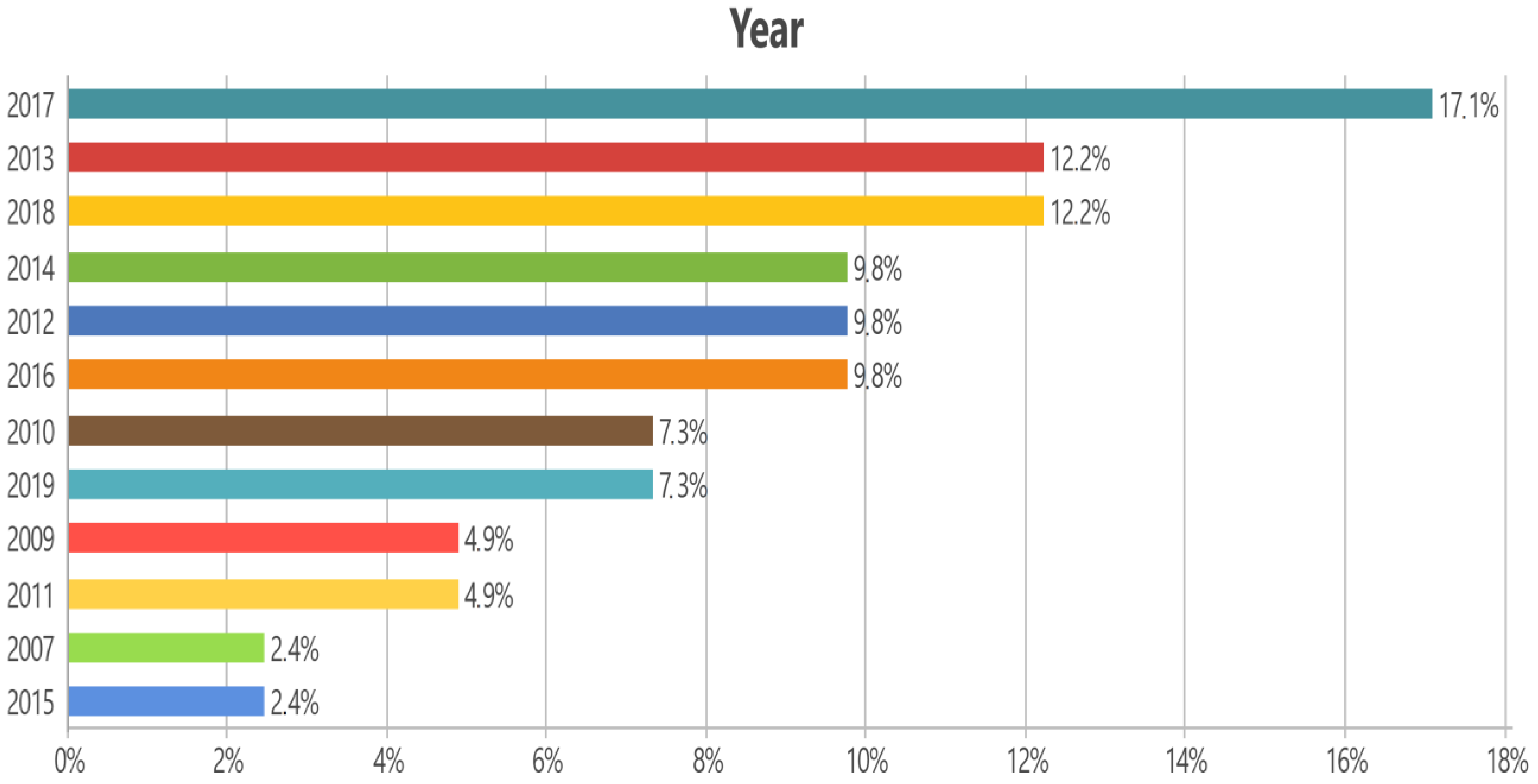
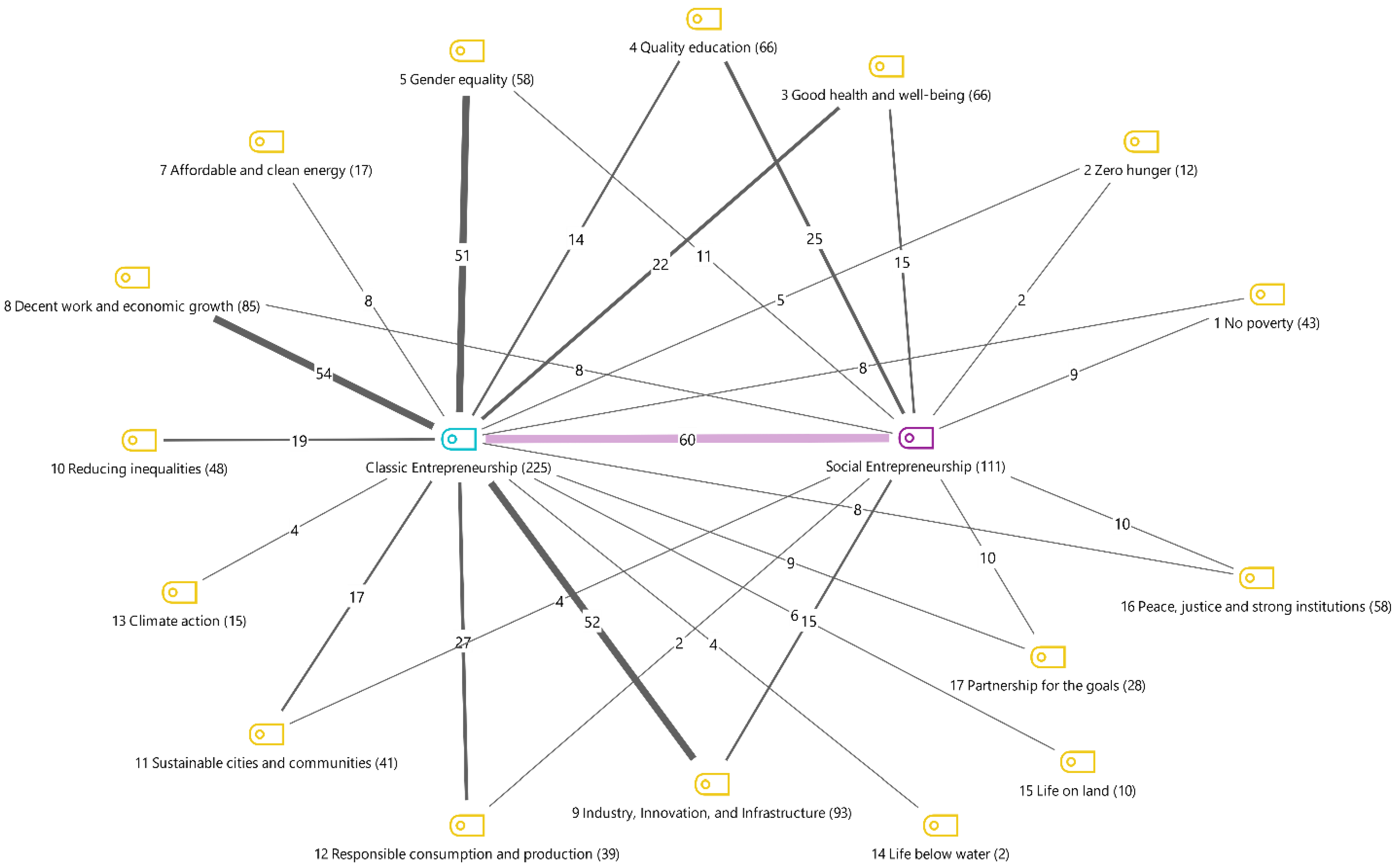
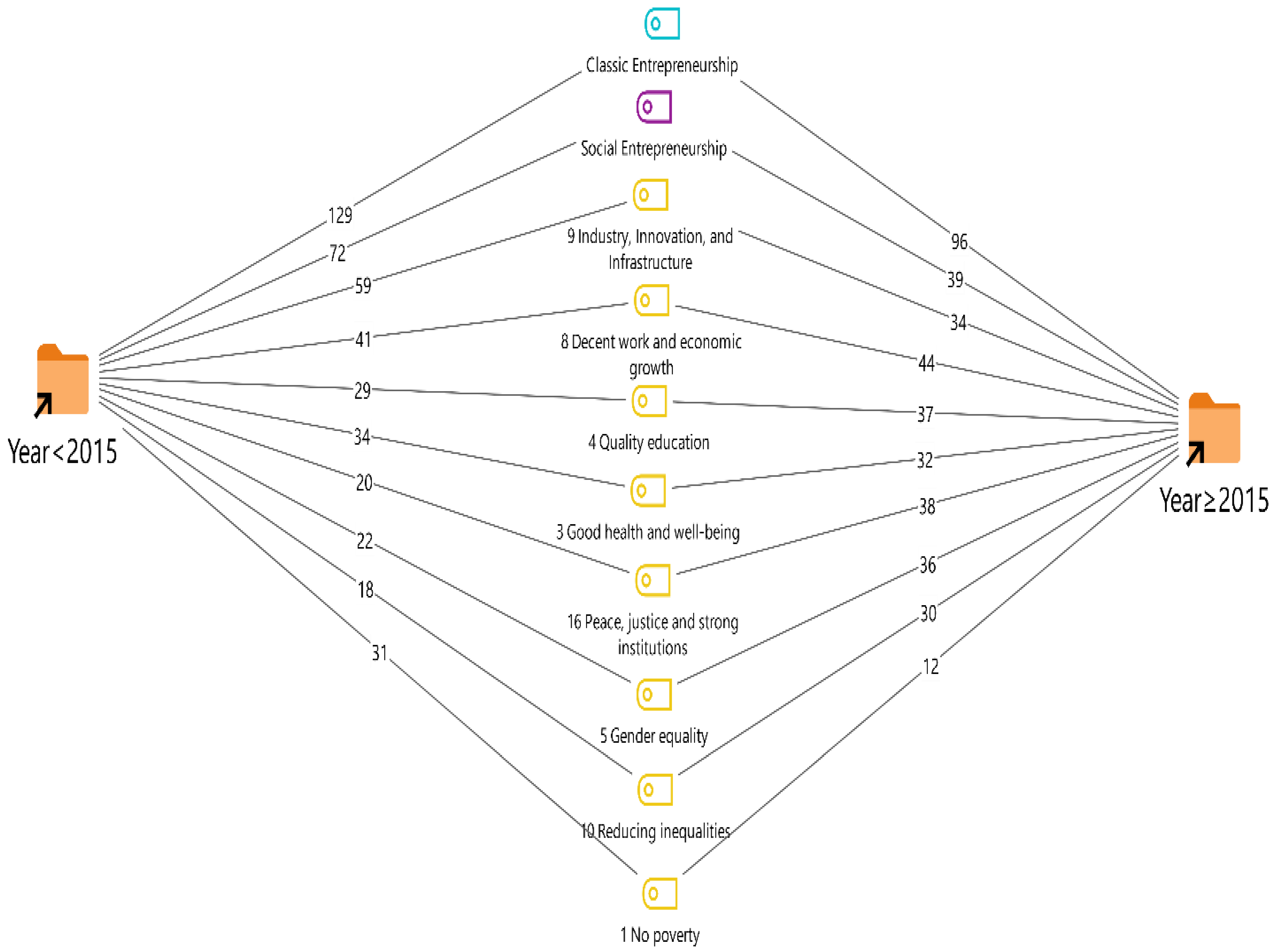
| Entrepreneurship Types | Studies |
|---|---|
| Environmental entrepreneurship | [16,17] |
| Eco entrepreneurship | [18,19] |
| Climate entrepreneurship | [14,20] |
| Biosphere entrepreneurship | [21] |
| Policy entrepreneurship | [22,23] |
| Institutional entrepreneurship | [24,25] |
| Sustainable entrepreneurship | [26,27,28,29] |
| Goal Number | Goal Name |
|---|---|
| 1 | No poverty |
| 2 | Zero hunger |
| 3 | Good health and well-being |
| 4 | Quality education |
| 5 | Gender equality |
| 6 | Clean water and sanitation |
| 7 | Affordable and clean energy |
| 8 | Decent work and economic growth |
| 9 | Industry, innovation, and infrastructure |
| 10 | Reduced inequality |
| 11 | Sustainable cities and communities |
| 12 | Responsible consumption and production |
| 13 | Climate action |
| 14 | Life underwater |
| 15 | Life on land |
| 16 | Peace, justice, and strong institutions |
| 17 | Partnership for the goals |
| Main Code | Subcode | Example TED Talk Excerpts Expressing Code |
|---|---|---|
| SE | Classic entrepreneurship | “I’m a robotics entrepreneur who spends most of my time in Africa.” |
| SE | Social entrepreneurship | “We also go to the houses. We have been charging car batteries. Instead of taking the money I earn home, I give it back to the refugee community as a business expense.” |
| SDG | 1. No poverty | “I was six years old when I first heard about poverty.” |
| SDG | 2. Zero hunger | “I have just learned that 70 percent of children don’t get enough prenatal nutrition.” |
| SDG | 3. Good health and well-being | “A variety of diseases develop in these environments, the most dangerous of which is trachoma.” |
| SDG | 4. Quality education | “None of the women I grew up with in Maryland were college graduates, never business graduates.” |
| SDG | 5. Gender equality | “In order to overcome the gender barriers of the period, I founded my own software house, one of the first of such initiatives in Britain.” |
| SDG | 6. Clean water and sanitation | “Today, more than 2.5 billion people in the world do not have full access to water and hygiene services.” |
| SDG | 7. Affordable and clean energy | “We can get all the energy we need from where we are in a clean, safe and inexpensive way.” |
| SDG | 8. Decent work and economic growth | “The employment crisis, in addition young people tell me they’re worried about employment, they’re afraid of not being able to find a job.” |
| SDG | 9. Industry, Innovation, and infrastructure | “What is demanded, I am repeating, the private sector can make a big difference, they can foster advocacy with big, creative thinking.” |
| SDG | 10. Reduced inequality | “Imagine yourself as a food investor in a place where your purchasing power helps create a more equal society for all.” |
| SDG | 11. Sustainable cities and communities | “If we do not take also the young people into account in the growth of our cities, if we do not provide opportunities for them, this waiting story will be the story of a new generation of cities as a gateway to terrorism, violence and gangs.” |
| SDG | 12. Responsible consumption and production | “To establish my own business for the design and manufacture of biodegradable packaging from waste such as paper, agricultural products and even textiles, instead of the disposable toxic plastic packaging that we are addicted to.” |
| SDG | 13. Climate action | “The pith of the matter is, even if CO2 production is good for the environment, our hydrocarbons will run out; we have to find sustainable working opportunities.” |
| SDG | 14. Life underwater | “An initiative to help reduce the billions of kilograms of single-use plastic packaging that is left every year to future generations, such as my grandchildren and your grandchildren, which pollute our environment, rivers, and oceans.” |
| SDG | 15. Life on land | “If plants were not pollinated by pollinators, all living beings dependent on these plants, including ourselves, would starve to death.” |
| SDG | 16. Peace, justice, and strong institutions | “My anger at corruption led me to make a major career change last year and become a full-time lawyer.” |
| SDG | 17. Partnership for the goals | “This equation includes you and of course your users as well as regulators, politicians and communities.” |
| Frequency | Percentage (%) | Percentage (%) | |
|---|---|---|---|
| Male | 22 | 53.66 | 53.66 |
| Female | 19 | 46.34 | 46.34 |
| Total | 41 | 100 | 100 |
| Sustainable Entrepreneurship | |||
|---|---|---|---|
| Social Entrepreneurship | Classic Entrepreneurship | ||
| SDGs | 1 No poverty | 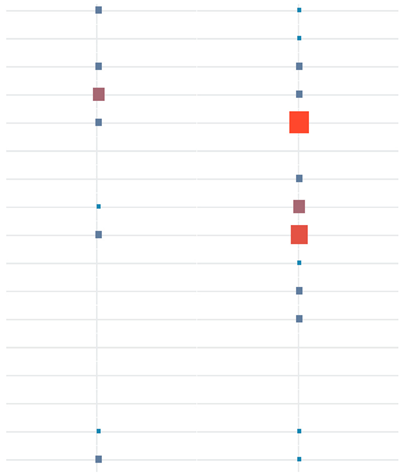 | |
| 2 Zero hunger | |||
| 3 Good health and well-being | |||
| 4 Quality education | |||
| 5 Gender equality | |||
| 6 Clean water and sanitation | |||
| 7 Affordable and clean energy | |||
| 8 Decent work and economic growth | |||
| 9 Industry, Innovation, and Infrastructure | |||
| 10 Reducing inequalities | |||
| 11 Sustainable cities and communities | |||
| 12 Responsible consumption and production | |||
| 13 Climate action | |||
| 14 Life below water | |||
| 15 Life on land | |||
| 16 Peace, justice and strong institutions | |||
| 17 Partnership for the goals | |||
| Category | Subcategory | Year | |
|---|---|---|---|
| <2015 | 2015≤ | ||
| Sustainable Entrepreneurship | Social Entrepreneurship | 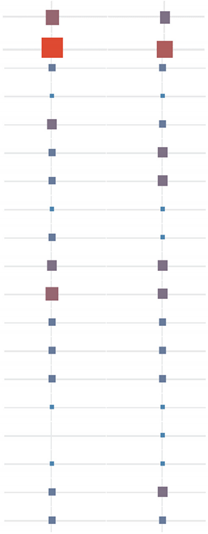 | |
| Classic Entrepreneurship | |||
| SDGs | 1 No poverty | ||
| 2 Zero hunger | |||
| 3 Good health and well-being | |||
| 4 Quality education | |||
| 5 Gender equality | |||
| 6 Clean water and sanitation | |||
| 7 Affordable and clean energy | |||
| 8 Decent work and economic growth | |||
| 9 Industry, Innovation, and Infrastructure | |||
| 10 Reducing inequalities | |||
| 11 Sustainable cities and communities | |||
| 12 Responsible consumption and production | |||
| 13 Climate action | |||
| 14 Life below water | |||
| 15 Life on land | |||
| 16 Peace, justice and strong institutions | |||
| 17 Partnership for the goals | |||
Publisher’s Note: MDPI stays neutral with regard to jurisdictional claims in published maps and institutional affiliations. |
© 2022 by the authors. Licensee MDPI, Basel, Switzerland. This article is an open access article distributed under the terms and conditions of the Creative Commons Attribution (CC BY) license (https://creativecommons.org/licenses/by/4.0/).
Share and Cite
Akkuş, Y.; Çalıyurt, K. The Role of Sustainable Entrepreneurship in UN Sustainable Development Goals: The Case of TED Talks. Sustainability 2022, 14, 8035. https://doi.org/10.3390/su14138035
Akkuş Y, Çalıyurt K. The Role of Sustainable Entrepreneurship in UN Sustainable Development Goals: The Case of TED Talks. Sustainability. 2022; 14(13):8035. https://doi.org/10.3390/su14138035
Chicago/Turabian StyleAkkuş, Yasin, and Kıymet Çalıyurt. 2022. "The Role of Sustainable Entrepreneurship in UN Sustainable Development Goals: The Case of TED Talks" Sustainability 14, no. 13: 8035. https://doi.org/10.3390/su14138035
APA StyleAkkuş, Y., & Çalıyurt, K. (2022). The Role of Sustainable Entrepreneurship in UN Sustainable Development Goals: The Case of TED Talks. Sustainability, 14(13), 8035. https://doi.org/10.3390/su14138035







